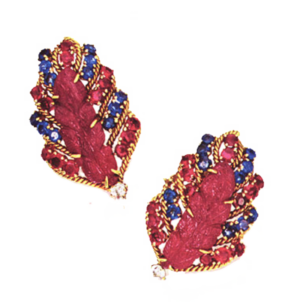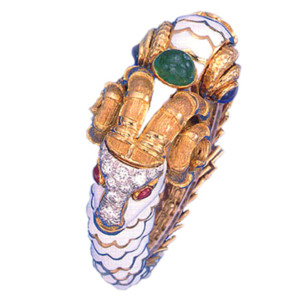David Webb was born in Ashville, North Carolina in 1926. He came to New York City when he was only sixteen, in order to pursue his passion for jewelry. He was fortunate in having an uncle in New York who had a workshop, and it was there that he learned the rudiments of working with precious materials, and began producing his own designs.
In 1946, when he was only 20 years old, he opened a location on 47th Street with business partner Nina Silberstein. It did not take long for his talent to be noticed. An important French Socialite living in New York City, Antoinette Quileret, was very taken by his work. In the early 1950’s ,She backed Webb opening his first shop on prestigious 57th Street, and David Webb Inc. was born.
He was an instant success, and employed over 200 skilled workers in two workshops. In addition to the 57th Street location, his jewelry was also being retailed at Bonwit Teller and Bergdorf Goodman. Mme. Quilleret had major social connections, and it was not long before he acquired a clientele of wealthy and sophisticated women, among them Jacqueline Kennedy, who not only wore his jewelry, but also commissioned him to design and make gifts for diplomatic occasions.
Webb drew his inspiration from themes that had emerged after the end of WW2. Animals, flowers and other aspects of the natural world were being explored by many designers as the return to Naturalism replaced the stylized forms of the 1930’s and 40’s. Webb’s most important competition came from two other very gifted jewelers who had come to New York from Europe – Fulco De Verdura, from Italy, and Jean Schlumberger, from France. In addition to attracting Society clientele, they also became the darlings of Hollywood actresses, who competed with each other to have the most stylish jewelry. Verdura and Schlumberger were also inspired by themes from the natural world, and while they each had their own vision, there was always some “borrowing” of ideas. There is a story that both Webb and Verdura were at a social event together, and Webb told Verdura how much he admired his work, to which Verdura replied “yes, so I have noticed”.
David Webb, however, was not a copier of others ideas. His visions for jewelry designs were endless and original. Like Verdura and Schlumberger, he used animals in his designs, but his pieces were much more stylized. For what became know as his Fantastical Jungle, he was indebted to Jeanne Toussaint, who designed her famous Panthers, lady bugs and turtles for Cartier. But again, he was not a rote copier. His Animal bracelets were cleverly designed so that the creature curved around the wrist, with the head facing the tail, and a hinged back. They were done in gold and colorful enamels, and often set with precious stones. There is hardly an animal that was not transformed into a brooch, pendant, bracelet or ring.
Webb was also inspired by historical references to the ancient world and exotic sources. Egypt, Greece, Rome, Aztec and Mayan, Mesopotamia, India and China. These varied inspirations were perhaps best displayed in the long, heavy chain necklaces with dramatic pendants. The pendants were often set with old Chinese jade carvings, and pieces from Mexico. He also loved semi-precious stones for his day-time jewelry. He loved the vibrant colors of coral, jade, lapis, and other stones, and combined them as a painter wold use colorful paints.
The settings and heavy chains were often done in his signature hammered gold. He also loved enamels, which were used extensively in his work, and had, in fact, become one of the defining post-war jewelry designs after being out of favor since the Art Nouveau period. He created striking jewelry using white enamel with or without stones for the perfect “summer” jewelry, also very popular for winters in Palm Beach and other fashionable places.
His inspired combination of enamels and colored stones earned him the title of “today’s Faberge”, and he often credited Faberge as one of his most important inspirations.
It was said that David Webb was the first jewelry to put women back into diamonds set in yellow gold. He designed bold rings, bracelets, earrings and brooches using diamonds and other precious stones set in yellow gold.
In the 1970’s Webb introduced jewelry inspired by Art Deco, which had become highly fashionable. Dramatically sized, chunky rings, earrings, bracelets and necklaces were designed using the favored Art Deco materials and color combinations – coral and onyx, lapis, frosted or carved rock crystal, often set with diamonds.
Sadly, David Webb died young – in 1975, at the age of 49. The business continued under the direction of his partner Nina Silberstein. Webb left behind a large body of work, and all of the drawing and moulds, and Webb continued to be successful drawing on this material, and remained on 57th Street under Ms. Silberstein for 35 years, and their presence expanded to Beverly Hills, Houston and Kuwait.
Webb himself, though, was no longer there to create new ideas, and gradually, fashions changed, and his jewelry fell somewhat out of favor. The New York shop moved to Madison Avenue sometime in the 1990’s under the direction of Nina’s son Stanley. In 2010, Webb was purchased by three prominent New York jewelry dealers, and the location was moved to new are larger space on Madison Avenue, with extensive workshop space. They no longer produce the old designs, preferring to introduce more current pieces.
Showing all 2 results



